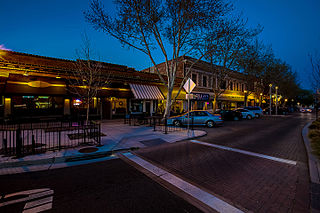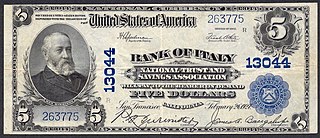
The Bank of Italy was founded in San Francisco, California, United States, on October 17, 1904 by Amadeo P. Giannini. It grew by a branch banking strategy to become Bank of America, the world's largest commercial bank, with 493 branches in California and assets of $5 billion in 1945.

The Heaviest Corner on Earth is a promotional name given to the corner of 20th Street and 1st Avenue North in Birmingham, Alabama, United States, in the early 20th century. The name reflected the nearly simultaneous appearance of four of the tallest buildings in the South, the 10-story Woodward Building (1902), 16-story Brown Marx Building (1906), 16-story Empire Building (1909), and the 21-story American Trust and Savings Bank Building (1912).
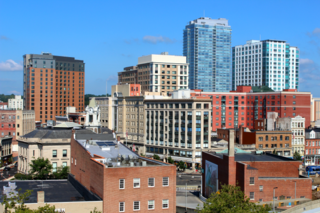
Downtown Stamford, or Stamford Downtown, is the central business district of the city of Stamford, Connecticut, United States. It includes major retail establishments, a shopping mall, a university campus, the headquarters of major corporations and fortune 500 companies, as well as other retail businesses, hotels, restaurants, offices, entertainment venues and high-rise apartment buildings.

This is a list of the National Register of Historic Places listings in Morrison County, Minnesota. It is intended to be a complete list of the properties and districts on the National Register of Historic Places in Morrison County, Minnesota, United States. The locations of National Register properties and districts for which the latitude and longitude coordinates are included below, may be seen in an online map.

The Hurt Building is an 18-story building located at 50 Hurt Plaza in Atlanta, Georgia with a unique triangular shape. One of the nation's earliest skyscrapers, the Hurt Building was built between 1913 and 1926, and was the initial home for the Federal Reserve Bank of Atlanta. It was renovated in 1985. It was added to the National Register of Historic Places in 1977.
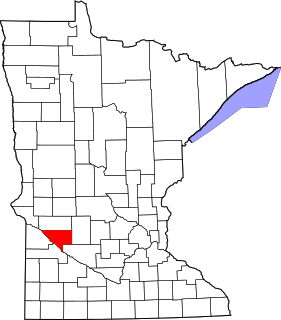
This is a list of the National Register of Historic Places listings in Chippewa County, Minnesota. It is intended to be a complete list of the properties and districts on the National Register of Historic Places in Chippewa County, Minnesota, United States. The locations of National Register properties and districts for which the latitude and longitude coordinates are included below, may be seen in an online map.
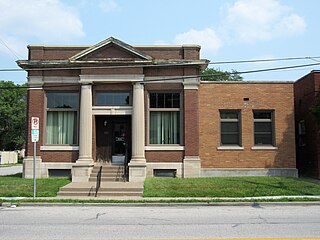
Northwest Davenport Savings Bank is a historic building located in a commercial district in the old northwest section of Davenport, Iowa, United States. It has been listed on the National Register of Historic Places since 1984.

This is a list of the National Register of Historic Places listings in Lac qui Parle County, Minnesota. It is intended to be a complete list of the properties and districts on the National Register of Historic Places in Lac qui Parle County, Minnesota, United States. The locations of National Register properties and districts for which the latitude and longitude coordinates are included below, may be seen in an online map.

The Old Astoria City Hall, now known as the Clatsop County Historical Society Heritage Museum, is a historic building located in Astoria, Oregon, United States, that is listed on the National Register of Historic Places. The building served as the city hall of Astoria from 1905 until 1939. It was the first location of the Columbia River Maritime Museum, from 1963 to 1982, and has been the Heritage Museum since 1985.
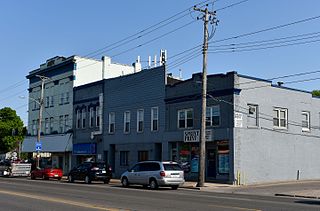
The College Corner Commercial Historic Business District, also known as the Highland Park Historic Business District at Euclid and Second, is located in the north-central section of Des Moines, Iowa, United States. It is located in the Highland Park neighborhood that also includes the Highland Park Historic Business District at Euclid and Sixth Avenues. The College Corner historic district has been listed on the National Register of Historic Places since 1998.

The Bank of Italy building is an historic 9-story, 38 m (125 ft) mid-rise in downtown Fresno, California. The building was completed in 1918 for the Bank of Italy, that later became the Bank of America. Its chief designer was Charles Franklin of the R.F. Felchlin Company. The completely vacant building is the ninth tallest in the city, and is listed on the U.S. National Register of Historic Places. The building was sold to the Penstar Group, a Fresno-based developer, in 2009.

The City National Bank (CNB) was a bank and is also the name of its historic building in Galveston, Texas, listed on the National Register of Historic Places (NRHP). The bank was founded in December 1907 by William Lewis Moody Jr. (1866–1954) and the building was completed in 1920. City National Bank renamed itself the Moody National Bank in 1953, to honor the founder. The downtown building served as the Galveston County Historical Museum until 2008, when it was badly damaged by Hurricane Ike, after which the museum's assets were moved to the Galveston County Courthouse. Since then, the former CNB building has been unused.

The Calaveras County Bank is a historic bank building located at 1239 Main St. in Angels Camp, California. The two-story Classical Revival building was built in 1900 and designed by architects E. Depierre and Perseo Righetti of San Francisco. The bank's design features an iron boxed cornice with brackets on each end and stone pilasters on both sides. The second floor has three double-hung sash windows, while the first floor has a picture window flanked by two entrances; all three first floor openings are topped with rounded arches. The interior trim of the bank used a variety of different woods, a rarity in contemporary buildings in the area. The bank was the first to be incorporated in Calaveras County, and the building was the first in the county designed specifically to house a bank; until the 1920s, it was also the only bank operating in the county. In 1930, the Calaveras County Bank merged with the Bank of Italy and moved to a new building. The old bank building housed a meat market from 1937 to 1980 and later held a branch of the Central Sierra Bank.

The First National Bank of Rock River was built in 1919 in the small community of Rock River, Wyoming, at the peak of a local oil boom. The First National Bank operated from February 1920 to June 14, 1923, when it went into receivership as the oil boom collapsed and its vice president was convicted of embezzlement. In 1927 the building was sold to the new Citizen's State Bank, but was claimed by Albany County for back taxes in 1931. In 1936 the county sold the building to the town. It became a civic center for the town, operating a post office until the 1950s. A doctor's office had occupied the rear in the 1920s, and in the 1940s apartments were built, which later bacme the town's jail. With the departure of the post office the building became a fire station. From 1935 to 1985 the Council Room was used by civic organizations. From 1940 to 1985 another room was the town library.
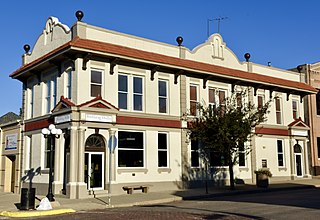
German Bank Building of Walnut, Iowa, also known as the Walnut State Bank Building, is a historic building located in Walnut, Iowa, United States. A two-story, brick building was completed on this corner in 1884. It housed a blacksmith shop and a land and loan business by 1887. The German Savings bank was organized in 1893, and used this building for a short time before it folded the following year. It was reorganized and re-opened in 1898. They renovated the building to its present exterior in the Mission Revival style in 1916, and the interior in 1920. The interior renovation was done by the St. Louis Bank Equipment Company. The Walnut Telephone Company began as a tenant on the second floor in 1919. While German immigrants remained in control, the bank's name was changed to American State Bank in 1920 because of anti-German sentiment following World War I. It was reorganized in 1923 as the Walnut State Bank. It was listed on the National Register of Historic Places in 1991.

State Savings Bank, also known as the Old Savings Bank, is a historic building located in Council Bluffs, Iowa, United States. the bank was established in 1889, and was originally located across the street. Planning for this building began in 1941 with the organization of the State Investment Company, which would build and own the building. It was designed by W.G. Knoebel and built by St. Louis-based Bank Building and Equipment Corporation of America. It is a late example of Art Deco, and it's the only building in Council Bluffs that exhibits this style. Two-thirds of the building is a single-story banking facility, and the rest is divided into two-stories of office space. It has one of the first drive-through teller windows in Iowa. The rectangular building's exterior is finished in gray limestone on two elevations, and a wrap-around continuation on a third. Its primary decorative feature is an inscribed harvest motif on the east and west elevations that are mirror images of each other, oriented to the north. The motif features a male nude holding a wagon wheel and a scythe, with sheaves of wheat and a dog.

The Old Guaranty Bank Building is a historic bank building located at 500 Jefferson Street in Lafayette, Louisiana.

The E. H. Dewey Stores in Nampa, Idaho, is the remnant of an L-shape building that once surrounded the Farmers and Merchants Bank at the corner of 11th Avenue and 1st Street. The L-shape was designed to contain two stores in each wing. The 1-story, stone and brick building was designed by Tourtellotte and Hummel and constructed in 1919, and it reveals a restrained Neoclassical architecture common in commercial buildings of the early 20th century. The building was added to the National Register of Historic Places in 1982.

The Tracy City Hall and Jail, also known as Old Tracy Jail, is a commercial structure in Tracy, California. Built in 1899, it was added to the National Register of Historic Places in 1979.

Bank of Tracy in Tracy, California is a historic commercial building completed in 1920. It was added to the National Register of Historic Places in 1980.

